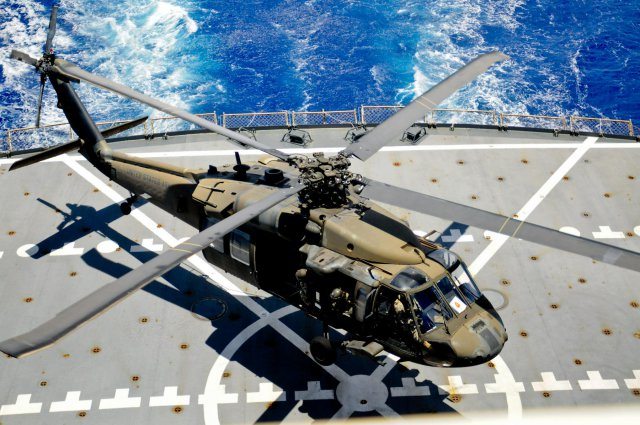Pilots and flight crews with the 25th Combat Aviation Brigade worked closely with the U.S. Navy to conduct deck landing qualifications aboard the USS Chafee (DDG-90), USS Hopper (DDG-70), USS Guadalupe (AO-32), and the USS Tarawa (LHA-1), in the Pacific Ocean near Hawaii, July 15-19.
More than 25 pilots from 2nd Squadron, 6th Cavalry Regiment; 2nd Battalion, 25th Aviation Regiment; and 3rd Battalion, 25th Aviation Regiment, qualified during the training, which certifies them to land and launch from the decks of moving Navy vessels during operations.
“We bring a capability that has mostly been land based in nature,” said Chief Warrant Officer 5 Joseph Roland, 25th CAB chief warrant officer of the brigade. “Being protectors of the Pacific, it is important we are capable of working in an over-water environment.”
In preparation for the deck landings, during the previous week, the air crews attended academic classes, performed field deck landing practices on ground and in simulators in order to ensure the pilots and crews were as prepared as possible before heading out to the Navy ships.
Many of the limits terrain place on aviation assets are bypassed through joint integration with the Navy.
“With the capability to launch from Navy ships operational planners can insert aviation assets into locations that were otherwise limited,” said Maj. Aaron Elliott, 25th CAB operations officer. “Now, we can operate across every coast in the Pacific.”
Deck landing qualifications were conducted with UH-60 Black Hawks, OH-58 Kiowa Warriors, and CH-47 Chinooks. Qualifying pilots across the three air frames opened up mission capabilities to include heavy and medium lift, reconnaissance, attack, air assaults and medical evacuation support.
“By successfully executing deck landing qualifications in our OH-58D, UH-60, and CH-47 aircraft types, we significantly expanded Pacific Command’s maritime operational capabilities at a strategic level,” said Lt. Col. Hunter Marshall, commander, 3-25 Aviation.
The training provided added value to the Navy on both on operational and individual level.
“This joint operation increases the capabilities for 5th Fleet throughout the [U.S. Central Command] area of responsibility,” said Navy Lt. Travis Anderson, operations officer, U.S.S. Hoper, DDG 70. “This extends our ability to track and reach out and touch someone.”
The joint operation also provided experience to Navy personnel who have active roles to play during helicopter operations to include helicopter controllers, flight deck crews and crash and salvage teams according to Anderson.
“For the Navy and Army to have the ability to strike quickly against a foe or respond for humanitarian aid to a foreign country here in the Pacific Region; this training allows for both branches to meet and accomplish that mission,” said Chief Petty Officer Tian Henry, chief operations specialist, USS Chafee (DDG-90). “We need to keep proficiency on both sides and continually challenge each other and grow in our capabilities as a Task Force.”










